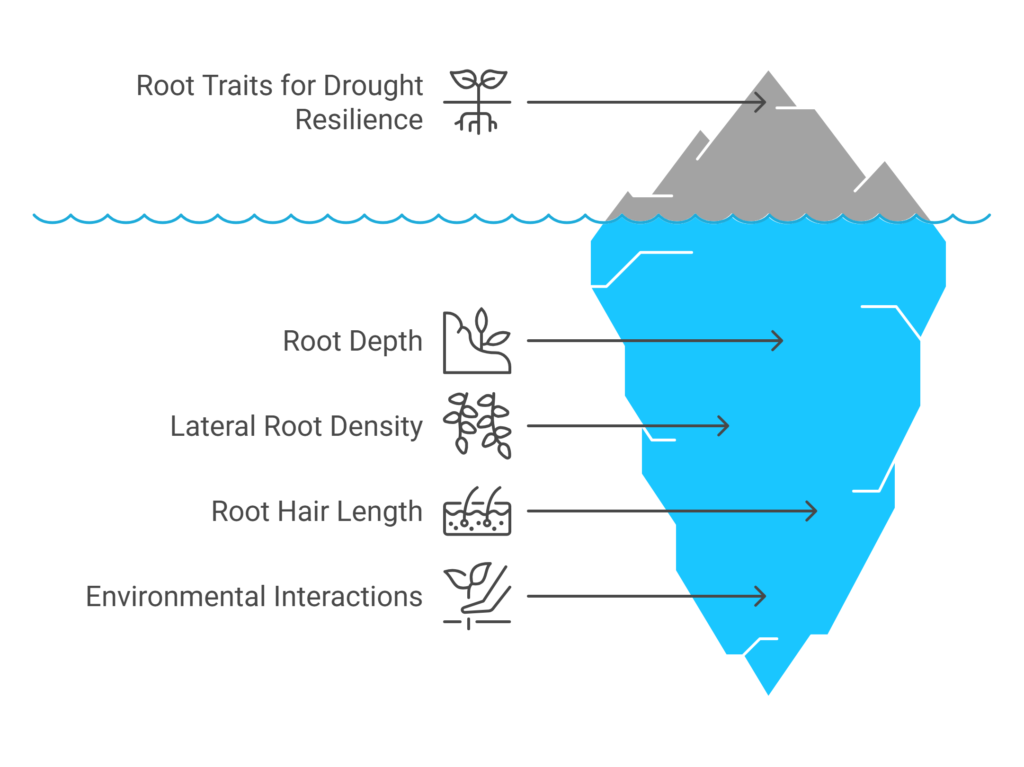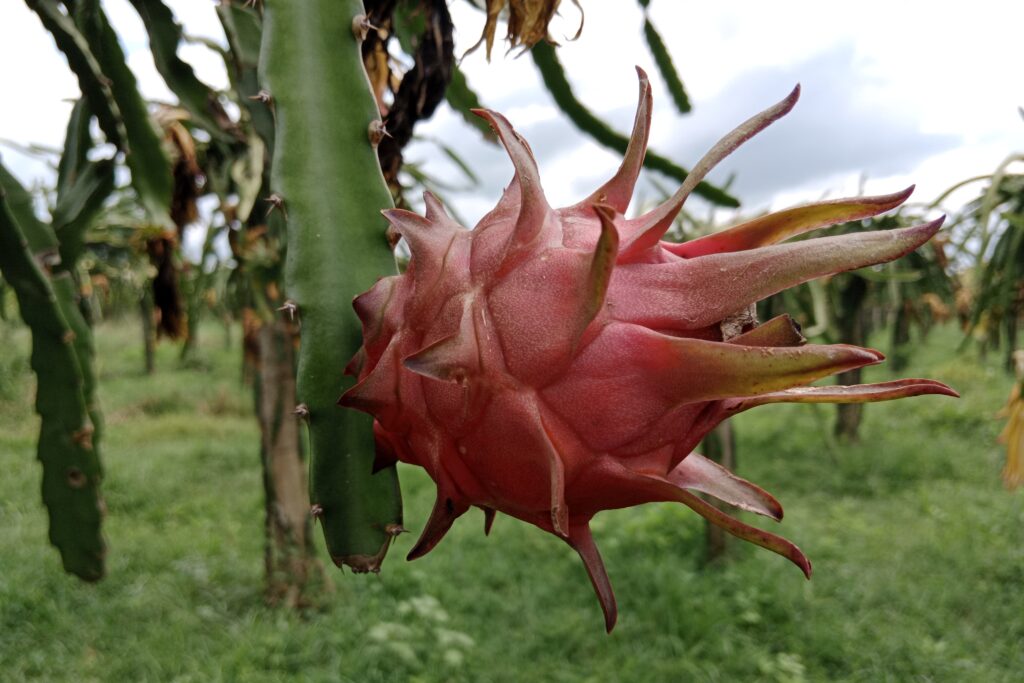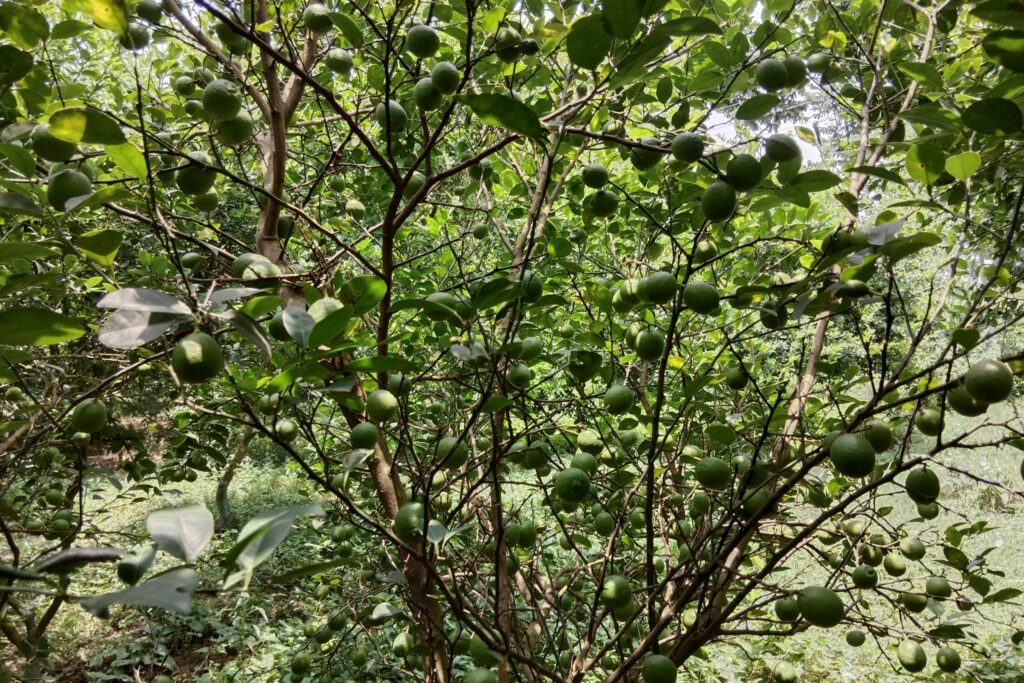Introduction
The frequency and intensity of drought episodes are increasing due to climate change, posing a serious threat to global food security. Wheat, one of the most extensively cultivated cereal crops, is particularly vulnerable to water stress; in severe cases, drought can reduce yields by up to 50% (FAO, 2022). Addressing this challenge is critical to sustaining agricultural productivity and meeting the demands of a growing global population. Advancing research in Plant Root Modelling for Drought Resilience offers a promising pathway to enhance wheat’s adaptability to water scarcity and ensure food security under changing climatic conditions.

The root system architecture (RSA) of plants plays a critical role in water uptake and drought resilience, acting as the primary interface between the plant and the soil. Root systems are broadly categorized into two types: taproot systems and fibrous systems.
Taproot systems feature a dominant primary root (taproot) accompanied by lateral roots, with factors such as the depth of the primary root, the arrangement of lateral roots, gravitropic angles, and environmental adaptability shaping soil exploration. In fibrous systems, comprising both embryonic and postembryonic roots, crown roots contribute significantly to the biomass of mature plants, while brace roots provide mechanical support.
Fine roots, which make up the majority of root length and surface area, are crucial in both systems for efficient nutrient absorption and the ability to explore soil micropores. These structural and adaptive characteristics collectively influence the root system’s effectiveness in acquiring resources and adapting to environmental conditions.
Key root characteristics, such as root depth, lateral root branching, and root hair density, have been linked to improved water uptake under drought conditions (Lynch, 2018). However, the relationships among these traits and their roles in enhancing drought resilience remain poorly understood. This gap in knowledge hinders the development of crops with superior performance in water-scarce environments, posing challenges for plant breeders and agronomists.
Through an inventive and multidisciplinary strategy, the DROOGHT (Drought-Root-Oriented Optimization for Growing High-yielding Traits) project seeks to address these issues. In order to find and refine structural root features that improve water uptake efficiency during drought, the research combines state-of-the-art computational modeling with sophisticated root phenotyping techniques. This project emphasizes the value of multiscale techniques to address complex agricultural difficulties by integrating plant physiology, computational biology, and agronomy (Postma et al., 2017).
With the use of a strong framework of sensitivity studies and multiscale computer modeling, the DROOGHT project hopes to close the gap between theoretical understanding and real-world implementations. Ultimately, the objective is to support sustainable agriculture by giving breeders practical information to create drought-resistant wheat cultivars that are adapted to the demands of a changing environment.
Literature Review
1. Importance of Root Traits in Drought Resilience
Roots are fundamental to a plant’s survival under drought conditions, serving as the primary interface for water and nutrient uptake from the soil. Their ability to penetrate deeper soil layers or efficiently explore the upper soil strata determines the extent of water and nutrient acquisition, particularly during prolonged periods of water scarcity (Lynch, 2018). Structural root traits such as root depth, lateral root density, and root hair length are critical for optimizing resource uptake in water-limited environments.

Deep rooting systems are especially advantageous in accessing moisture from subsoil layers that are less prone to rapid drying. Studies have demonstrated that increased root depth correlates with enhanced drought resilience in crops, as these systems enable sustained water uptake during critical growth stages (Uga et al., 2013). Similarly, lateral root density and branching patterns play a pivotal role in maximizing soil exploration. Greater lateral root proliferation allows plants to efficiently capture available water and nutrients in the topsoil, which is critical in semi-arid regions with irregular precipitation patterns.
Another vital trait is root hair length and density, which significantly enhances the root’s surface area, improving water and nutrient absorption capacity. Root hairs also play a key role in facilitating phosphorus uptake in low-phosphorus soils, further contributing to plant growth under nutrient-stressed conditions (Zhu et al., 2010).
Despite these benefits, accurately phenotyping root traits remains a formidable challenge due to the opacity of soil, which obscures direct observations of root growth and architecture. Advanced phenotyping techniques such as X-ray computed tomography, soil coring, and rhizotron systems are improving our ability to measure root traits in controlled environments.
However, the transferability of these findings to field conditions is often limited by the complexity of environmental interactions, including soil structure, temperature, and moisture gradients. These challenges underscore the need for integrative approaches that combine computational modelling with experimental phenotyping to better understand the role of root traits in drought resilience (Postma et al., 2017).
2. Advances in Computational Modelling
Recent advancements in computational modelling have significantly enhanced our ability to study root systems and their interactions with the environment. These models simulate root growth, architecture, and function with remarkable precision, providing a platform to predict plant responses under various environmental conditions (Postma et al., 2017). Computational models range from simple rule-based frameworks to complex mechanistic models that account for dynamic interactions between roots, soil, and environmental variables.

Multiscale Modelling
One of the most impactful developments is multiscale modelling, which bridges the gap between organ-level processes and whole-plant performance. At the organ level, models can simulate root elongation, branching, and gravitropic responses, capturing the spatial and temporal dynamics of root growth. When integrated into a whole-plant context, these models allow researchers to study how root traits influence water and nutrient uptake efficiency across diverse soil and climate conditions.
Role of Sensitivity Analysis
Researchers can now determine which root characteristics have the most impact on water intake and drought tolerance thanks to sensitivity analysis, which has become a vital technique in computational modeling. By examining the effects of minor changes in individual factors, local sensitivity analysis sheds light on the ways in which particular features influence water uptake. Global sensitivity analysis, on the other hand, assesses the combined impacts of several parameters, which aids in determining how root characteristics interact synergistically and how they affect plant performance under water stress.
Applications in Trait Optimization
These computational tools are invaluable for guiding breeding programs aimed at improving drought tolerance. By simulating root system responses under a range of soil moisture conditions, models can identify the most impactful traits for specific environments. For example, simulations have demonstrated that traits such as increased root depth and enhanced lateral root density significantly improve water uptake under prolonged drought, informing targeted breeding strategies (Lynch et al., 2014).
Computational models have drawbacks despite their potential. It might be difficult to get high-quality data on root architecture and function in the field, which is necessary for accurately parameterizing models. Moreover, complicated soil-root interactions including microbial impacts and soil heterogeneity are frequently difficult for models to capture. Continuous improvements in data collection methods, like high-throughput phenotyping and 3D root imaging, are assisting in overcoming these obstacles and enhancing the precision and usefulness of root system models.
Through their capacity to integrate experimental data with theoretical frameworks, computational models provide a powerful tool for advancing our understanding of root systems and their role in drought resilience. These models hold promises for accelerating the development of crops that can thrive in an increasingly water-limited world.
Research Gap
Despite advancements in root system modelling, a critical disconnect persists between silico insights and actionable agronomic strategies, compounded by the absence of models employing global sensitivity analysis to evaluate synergistic interactions among traits and environmental variables.
Existing frameworks often narrowly target isolated root characteristics or specific conditions, restricting their utility in heterogeneous field environments, while insufficient integration of computational approaches with empirical root phenotyping data further limits translational relevance.
This study bridges these gaps by synergizing multiscale computational modelling, local and global sensitivity analyses, and experimental phenotyping to systematically identify and optimize drought-resilient root traits, thereby enhancing model robustness and applicability to real-world agricultural challenges.
Hypothesis
Structural root traits, such as increased root depth and optimized lateral root branching, enhance water uptake efficiency under drought conditions. Computational models integrating local and global sensitivity analyses can identify trait combinations that maximize drought resilience and inform breeding programs for sustainable agriculture.
Objectives
- Develop a multiscale root modelling framework to simulate water uptake dynamics under varying environmental conditions.
- Conduct local and global sensitivity analyses to identify key root traits and their interactions affecting water uptake.
- Integrate experimental data from root phenotyping to validate and refine model predictions.
- Reverse-engineer root trait combinations that optimize water uptake and propose actionable recommendations for breeders.
- Foster international collaboration by working with leading labs such as INRAE to ensure robust model validation and knowledge exchange.
Materials and Methods
1. Development of Computational Models
This involves creating a multiscale root modeling framework using Python and MATLAB to simulate root growth and water uptake dynamics across diverse soil moisture conditions. This framework integrates numerical simulations to analyze how roots adapt to fluctuating environmental factors and incorporates sensitivity analysis tools to systematically evaluate the influence of individual and combined root traits—such as hydraulic properties, architectural parameters, and physiological responses—on overall system behavior.
By combining mechanistic modeling with trait-based assessments, the approach aims to quantify the relative contributions of specific traits under varying scenarios, providing insights into root-soil interactions and informing strategies for optimizing water-use efficiency in agricultural or ecological contexts.
2. Root Phenotyping and Data Integration
Root Phenotyping and Data Integration,” focuses on leveraging collaborations with INRAE to acquire high-resolution phenotypic data derived from advanced root imaging techniques, such as X-ray tomography and 3D microscopy, to inform and refine computational models.
This experimental data is systematically integrated into model parameterization processes, enhancing the accuracy and biological relevance of simulations by aligning theoretical predictions with empirical observations of root architecture, growth patterns, and functional traits.
By bridging empirical phenotyping with computational frameworks, the approach facilitates iterative model refinement, enabling dynamic adjustments based on real-world data to better capture root-soil interactions and physiological responses.
This synergy between experimental data and modeling efforts aims to improve predictive capabilities, validate mechanistic hypotheses, and support the development of targeted agricultural or ecological strategies informed by robust, data-driven insights into root system behavior.
3. Sensitivity Analysis
Sensitivity Analysis employs a dual approach to assess root trait influences: local sensitivity analysis is applied to quantify the effects of small-scale variations in individual traits—such as root hydraulic conductivity or branching patterns—on model outputs, while global sensitivity analysis examines interactions and synergies among multiple traits to identify dominant combinations driving system behavior under diverse environmental conditions.
This hierarchical framework disentangles the relative contributions of specific parameters and their interdependencies, enabling a nuanced understanding of how trait variability impacts root growth, resource uptake, and stress resilience. By integrating both methods, the analysis not only refines model robustness but also informs trait prioritization for breeding or management strategies, linking theoretical predictions to practical applications in optimizing root system adaptation to dynamic soil-water regimes.
4. Reverse-Engineering Optimal Traits
This utilizes computational model outputs to systematically identify root trait combinations—such as hydraulic efficiency, branching density, or root elongation rates—that maximize drought resilience under water-limited conditions.
By linking silico predictions with empirical validation, this approach cross-compares model-derived trait optima against experimental datasets and field-based agronomic trials to assess their biological feasibility and performance in real-world scenarios.
The iterative validation process ensures robustness, refining theoretical insights into actionable targets for crop breeding or adaptive management. This strategy bridges mechanistic modeling with practical applications, enabling the prioritization of traits that enhance stress adaptation while balancing trade-offs, ultimately guiding the development of drought-resistant root systems informed by both computational rigor and empirical evidence.
5. Dissemination of Results
This focuses on ensuring broad accessibility and impact of research outcomes by publishing findings in peer-reviewed journals and presenting insights at international conferences to engage academic, agricultural, and ecological communities.
This effort is complemented by active participation in Open Science initiatives, where computational models, datasets, and analytical tools are shared through public repositories or platforms, promoting transparency, reproducibility, and collaborative innovation. By prioritizing open access and interdisciplinary dialogue, the dissemination strategy not only amplifies the reach of the research but also invites scrutiny, validation, and adaptation of the work by global stakeholders.
This dual approach—combining traditional academic channels with open-source contributions—aims to accelerate the translation of theoretical advancements into practical solutions, fostering community-driven progress in understanding root-soil systems and enhancing strategies for sustainable resource management.
Work Plan
Year 1: Framework Development and Initial Data Integration
a). Model Development
- Develop the foundational multiscale root modelling framework in Python and MATLAB.
- Integrate basic environmental parameters (e.g., soil moisture gradients, root hydraulic properties) into the model.
b). Literature Review and Sensitivity Analysis Setup
- Conduct an in-depth review of existing computational root models and sensitivity analysis techniques.
- Design the structure for local and global sensitivity analyses.
c). Initial Data Collection and Parameterization
- Collaborate with INRAE to collect initial root phenotyping data (e.g., X-ray tomography, 3D imaging).
- Parameterize the model with preliminary experimental data to establish a baseline simulation.
d). Pilot Testing
- Perform pilot simulations to test the framework and identify any computational or biological inconsistencies.
- Present initial findings in an internal seminar or workshop for feedback.
Year 2: Sensitivity Analysis and Experimental Validation
a). Sensitivity Analysis
- Conduct local sensitivity analyses to evaluate the impact of individual root traits (e.g., root depth, branching patterns) on water uptake.
- Initiate global sensitivity analyses to explore trait interactions and synergies under various drought scenarios.
b). Data Integration and Model Refinement
- Incorporate additional high-resolution phenotyping data from INRAE into the model.
- Validate model outputs with empirical data to ensure biological accuracy.
c). Collaboration and Knowledge Exchange
- Organize a collaborative workshop with INRAE and other partners to share methodologies and refine research goals.
d). Preliminary Publications
- Submit a research paper detailing the development of the model and initial sensitivity analysis results.
Year 3: Trait Optimization and Advanced Validation
a). Trait Optimization
- Use the computational framework to reverse-engineer optimal root trait combinations for drought resilience.
- Cross-validate model predictions with empirical data from controlled greenhouse experiments.
b). Field Data Integration
- Expand the model to include data from field trials, addressing environmental heterogeneity and soil-plant interactions.
c). Refinement of Sensitivity Analysis
- Refine global sensitivity analysis based on field data to account for real-world complexities.
d). Dissemination of Intermediate Results
- Present findings at international conferences and publish a paper on optimized root traits and their validation.
Year 4: Validation, Dissemination, and Implementation
a). Final Validation
- Conduct comprehensive validation of the model using independent datasets.
- Test optimized root traits in larger-scale field trials in collaboration with breeders.
b). Dissemination
- Publish key findings in high-impact journals focusing on plant physiology, computational biology, and agronomy.
- Share computational models, data, and analytical tools via Open Science platforms.
c). Engagement with Breeding Programs
- Collaborate with breeding institutions to translate findings into actionable strategies.
- Develop practical guidelines for breeders focusing on drought-resilient root traits.
d). Completion and Reporting
- Compile a comprehensive final report summarizing the project outcomes, challenges, and future directions.
- Propose follow-up projects or collaborations based on the insights gained.
Expected Outcomes
- A validated multiscale root modelling framework that accurately simulates water uptake dynamics.
- Identification of key root traits and trait combinations that enhance drought resilience.
- Practical recommendations for breeding programs aimed at developing drought-resistant cereal crops.
- Enhanced collaboration and knowledge exchange between leading research institutions.
References
- Álvarez, R.R., Lobet, G., Lindner, H., Pradier, P.L., Sebastian, J., Yee, M. C., Geng, Y., Trontin, C., LaRue, T., Lavelle, A.S., Haney, C.H., Nieu, R., Maloof, J., Vogel, J.P., Dinneny, J.R. (2015) GLO-Roots: an imaging platform enabling multidimensional characterization of soil-grown root systems eLife.
- Draye, X., Kim, Y., Lobet, G., Javaux, M. (2010). Model-assisted integration of physiological and environmental constraints affecting the dynamic and spatial patterns of root water uptake from soils. Journal of Experimental Botany, 61(8), 2145–2155.
- (2022). The State of Food and Agriculture: Climate change and its impact on global crop yields. Food and Agriculture Organization of the United Nations.
- Lobet, G., Couvreur, V., Meunier, F., Javaux, M., Draye, X. (2014). Plant Water Uptake in Drying Soils. Plant Physiology, 164 (4), 1619–1627.
- Lobet,G., Pound, M.P., Diener, J., Pradal, C., Draye, X., Godin, C., Javaux, M., Leitner, D., Meunier, F., Nacry, P., Pridmore, T.P., Schnepf, A. (2015). Root System Markup Language: Toward a Unified Root Architecture Description Language. Plant Physiology, 167(3), 617–627.
- Lynch, J. P. (2018). Root phenotypes for improved nutrient capture: An underexplored opportunity for global agriculture. New Phytologist, 223(2), 548-564.
- Postma, J. A., Kuppe, C., Owen, M. R., Mellor, N., Griffiths, M., Bennett, M. J., & Lynch, J. P. (2017). OpenSimRoot: Widening the scope and application of root architectural models. New Phytologist, 215(3), 1274-1286.
- Postma, J. A., Kuppe, C., Owen, M. R., Mellor, N., Griffiths, M., Bennett, M. J., & Lynch, J. P. (2017). OpenSimRoot: Widening the scope and application of root architectural models. New Phytologist, 215(3), 1274-1286.
- Schnepf, A., Leitner, D., Landl, M., Lobet, G., Mai, T.H., Morandage,S., Sheng, C., Zörner, M., Vanderborght, J., Vereecken, H. (2018). CRootBox: a structural–functional modelling framework for root systems, Annals of Botany, Volume 121, Issue 5, 18 April 2018, Pages 1033–1053.
- Uga, Y., Sugimoto, K., Ogawa, S., Rane, J., Ishitani, M., Hara, N., & Yano, M. (2013). Control of root system architecture by DEEPER ROOTING 1 increases rice yield under drought conditions. Nature Genetics, 45(9), 1097-1102.
- Yu, P., Li, C., Li, M. et al. (2024). Seedling root system adaptation to water availability during maize domestication and global expansion. Nat Genet56, 1245–1256.
- Zhu, J., Kaeppler, S. M., & Lynch, J. P. (2010). Topsoil foraging and phosphorus acquisition efficiency in maize (Zea mays). Functional Plant Biology, 32(4), 749-762.


